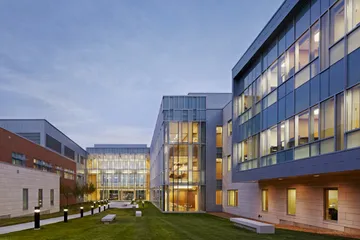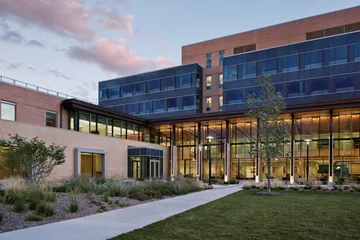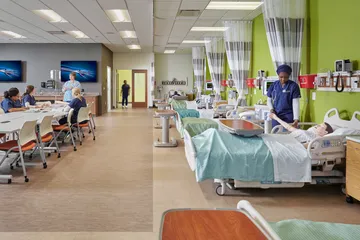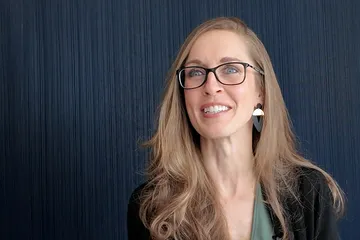Interview with an Expert: Larry Schnuck
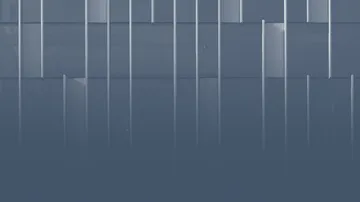
Larry Schnuck has been designing spaces for educating nursing, health sciences, medical and dental students for over 20 years. As a leader of Kahler Slater's Higher Education Team, he plays a key role in translating best practices in education into environments which foster hands-on learning around the country. A Vice President of the firm, Larry is also responsible for nurturing a diverse, collaborative environment that leads to creative solutions for all of our clients.
Here Larry shares some insights into what inspires him and where he sees the future of health sciences education heading.

What first drew you to the field of architecture and design?
My high school drafting classes, as well as guidance from my instructor Mr. Karnes, initially fueled my interest. At that time, I enjoyed developing ideas for houses. I loved to work out small details and creating places I thought would be fun to live in. Most often the settings for the houses were more rural then urban. Looking back, I do not know if I would live in those early house designs! My vision has definitely evolved, and I am much more a modernist in my approach to design and problem-solving.
What drives your passion for designing for health sciences education?
I love seeing how our building designs can impact the entire university campus and even the surrounding community. The energy that the faculty, students and staff bring to a project is inspiring, especially when you consider that we’re looking to educate the next generation of healthcare providers. I enjoy being a part of a team that fuels this excitement and translates it into the design of a building. Because we focus on health sciences, we also get to blend health education and healthcare concepts to help create a smooth transition for students as they move from classroom to hands-on patient care.
Some of my favorite projects have been those that bring together diverse users, for instance academic partners and private industries such as health care providers. These types of projects are becoming more common around the country, and it is an exciting challenge for us as a design team to balance the needs of each user with the overall vision for the project. For example, our work at Union Square Campus brought together seven different entities, including University of North Carolina-Greensboro, North Carolina A&T State University, Guildford Technical College and Cone Health to design a new campus focused on nursing education. It was both challenging and rewarding to be part of a team that brought together the entire community in Greensboro to explore new ways to share resources and focus on a common goal to expand their ability to train nurses.
What is the biggest influence you see impacting the design of future academic health sciences environments?
There is a lot to be said about the importance of students learning by doing, not just listening. Many of the means and methods of health science education continue to evolve from didactic to active learning and simulation methodologies. There is definitely more emphasis placed on competency-based measurement and a current challenge is to determine how the effects of the Coronavirus pandemic will impact this need in years to come. Additionally, the integration of technology and virtual reality will transform learning.
However, we believe that the most influential current and future impact is the focus on team-based interdisciplinary learning. As the healthcare industry evolves, teams of doctors, nurses, physician assistants, nutritionists, therapists, social workers, and pharmacists will work together to provide consultative team-based care. Health science education is responding to this by creating curricula and environments which are more interprofessional and collaborative. This approach will require our designs to go beyond organizing spaces strictly by program. This will mean that, teamed with our clients, we will investigate and create designs that more holistically share spaces and resources between these historically separate programs.
What is the most challenging part of being a designer?
In partnering with my clients, it is extremely important to understand and translate their vision for the project, and create a design that captures that vision. As designers, we are good listeners. We analyze individual needs and perspectives and balance them with the overall project vision and goals, while providing expert guidance and mentorship.
An often more subtle, but very important aspect of every project is understanding how the facility will impact and be integrated into the existing campus and neighborhood environment. The project design needs to embody a “campus culture” and represent the institution in a way that supports the development and enhances the unique campus “brand”. Well-designed new facilities also create a reinvigorated sense of place for spaces beyond the project, which often include a focus on health and wellness by integrating environmentally sensitive materials and lifestyle amenities.
What project have you worked on that resulted in a major transformation for a client?
It would have to be the creation of the new health sciences campus for Mary Baldwin University in Virginia. The project came as the result of the launch of new health sciences graduate programs for the University, which required a new dedicated facility. This project gave our team the opportunity to collaborate with visionary leaders to push the boundaries for interprofessional learning. It is amazing to see how incredibly successful the College of Health Sciences has been for both the expanded programs and the University. We were part of the team that helped them realize their vision to expand their academic offerings, thereby helping to secure a more secure future for the University. This facility and these programs expanded their enrollment, and ultimately helped them improve the lives and health of their fellow Virginians.
Beyond Mary Baldwin University, I am truly proud of every project my team has worked on because I believe all our projects provide a transformation for our clients. In some cases, it could be for the way the project supported a change in curriculum for teaching, and in-turn, learning. In others, it could be the way a project stitched together the fabric of a campus, thereby strengthening the overall campus and enhancing the student experience. I’m extremely grateful for the continuous opportunities we have to change the future of education.
Want to know more? Connect with Larry via email or through LinkedIn.
